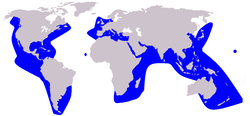Risso's Dolphin
|
|
| Risso's Dolphin Conservation status: Data deficient | ||||||||||||||||
|---|---|---|---|---|---|---|---|---|---|---|---|---|---|---|---|---|
| Missing image Rissos_dolphin.JPG A surfacing Risso's Dolphin | ||||||||||||||||
| Scientific classification | ||||||||||||||||
| ||||||||||||||||
| Binomial name | ||||||||||||||||
| Grampus griseus (G. Cuvier, 1812) | ||||||||||||||||
 Risso's Dolphin range |
The Risso's Dolphin (Grampus griseus) is the only species of dolphin in the genus Grampus.
| Contents |
Taxonomy
Risso's Dolphin was first described by Cuvier in 1812. The species' common name is for Mr. Risso who described a specimen to Cuvier on which Cuvier made his first description. Another common name for Risso's Dolphin is the Grampus (also the species genus) - although as a common name was historically used to describe the Orca. The etymology of the word grampus is unclear. It may be an aglomeration of the Latin grandis piscis or French grand poisson both meaning big fish. The specific name griseus refers to the mottled (almost scarred) grey colour of the dolphin's body.
Physical description
The most obvious feature of this large (up to 3.8m) dolphin is the large dorsal fin, superficially like that of a young or female Orca. The main body colour is very variable, from dark grey in young animals to almost white in old adults. The underside of this heavily built animal is white. Older animals are usually heavily scarred from confrontations with other Risso's or with squid.
The head profile is almost square, somewhat like a Sperm Whale, and the flippers are long and tapering. It will form moderately sized groups, and will mix with other dolphins, but it is not particularly attracted to ships.
The Risso's Dolphin eats mainly squid and fish.
Risso's Dolphin tend to live in groups of about 10-50. No life history data is available.
Population and distribution
It is found worldwide in temperate and tropical waters, usually in deep waters rather than close to land. As well as the warm watered parts of the Indian, Pacific and Atlantic Oceans, Risso's are found in the Mediterranean and Red Seas, though are absent from the Black Sea. Their preferred environment is just off the continental shelf on steep banks (with water depths varying from 400-1000m) with water temperature at least 10° C and preferably in excess of 15° C.
The population around the shelf of the United States has been recorded to be in excess of 60,000. In the Pacific a census recorded 175,000 individuals in eastern tropical waters and 85,000 in the west. No global estimate of population exists.
Human interaction
Risso's Dolphins generally do not approach boats. A notable exception was an individual named Pelorus Jack who accompanied boats in Admiralty Bay in New Zealand's Marlborough Sounds for more than 20 years. Whaling of this species has never been particularly widespread though operations off Sri Lanka may be significantly damaging the local population. Globally the species is recognised as abundant and safe.
Risso's have been taken into capitivity successfully in the United States and Japan, though with nowhere near the regularity of Bottlenose Dolphins or Orca. Hybrid Risso's-Bottlenose Dolphins have been bred in captivity.
References
- National Audobon Society Guide to Marine Mammals of the World ISBN 0375411410
- Encyclopedia of Marine Mammals ISBN 0125513402
- Whales, Dolphins and Porpoises, Mark Carwardine, ISBN 0751327816de:Rundkopfdelfin
